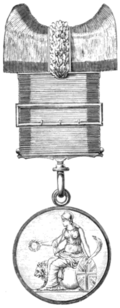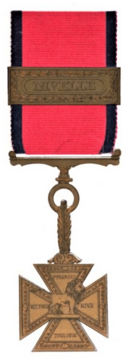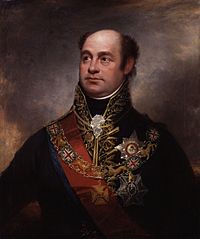Army Gold Medal facts for kids
The Army Gold Medal and Gold Cross were special awards given to British Army officers between 1808 and 1814. These medals recognized successful leaders during important military campaigns, especially the Peninsular War. Unlike other medals, these were only for high-ranking officers, like those leading a whole battalion or more.
Contents
Why Were These Medals Created?
Honoring Brave Leaders
Before the Army Gold Medal, there were similar awards for naval heroes. Since 1794, Naval Gold Medals were given to captains and admirals for winning sea battles. In 1806, a special gold medal was created for British Army majors and higher ranks who played a key part in the Battle of Maida.
This early medal, about 3.8 cm wide, showed King George III on one side. The other side featured Britannia, a symbol of Britain, and a Sicilian triskeles. It was a way to honor specific acts of bravery and leadership.
A Medal for All Soldiers?
It's important to know that these gold medals were just for officers. A general medal for all British soldiers, no matter their rank, only came much later in 1847. That medal covered many of the same wars, including the Napoleonic Wars.
How Were the Awards Given?
Starting the Army Gold Medal
The Army Gold Medal was officially started in 1810. It was given for service in battles from 1808 onwards during the Napoleonic Wars. Like the Maida medal, it was only for officers who were majors or higher.
There were two sizes: a larger one for very senior officers and a smaller one for others. At first, officers received a new medal for each battle they won.
Adding Clasps and the Gold Cross
By October 1813, the army decided to change how the awards worked. To avoid officers wearing too many medals, they introduced clasps. A clasp is a small bar attached to the medal's ribbon. If an officer won another award, they would get a clasp instead of a new medal. The clasp would have the name of the new battle on it.
If an officer earned a fourth award, they would receive a Gold Cross instead of more medals. This cross would replace their earlier medals. The names of the four battles would be engraved on the arms of the cross. For any awards after that, more clasps would be added to the ribbon of the Gold Cross.
These awards could even be given after an officer had died. In such cases, the medal or cross would be sent to their family.
How Many Awards Were Given?
Many officers earned these special awards. Here's a quick look at the numbers:
| Type of Award | Number Given | Clasps Given |
|---|---|---|
| Large Gold Medal | 88 medals | 43 clasps |
| Small Gold Medal | 596 medals | 237 clasps |
| Gold Cross | 163 crosses | 241 clasps |
The Most Awards Earned
The officer who earned the most awards was Arthur Wellesley, 1st Duke of Wellington. He received a Gold Cross with nine clasps, meaning he was recognized for 13 different battles! You can see his uniform and awards at Apsley House in London.
Other officers who earned many clasps included:
| Officer | Clasps | Battles |
|---|---|---|
| Arthur Wellesley, 1st Duke of Wellington | 13 | Roleia & Vimiera, Talavera, Busaco, Fuentes D'Onor, Ciudad Rodrigo, Badajoz, Salamanca, Vittoria, Pyrenees, Nivelle, Nive, Orthes, Toulouse |
| William Beresford, 1st Viscount Beresford | 7 | Corunna, Busaco, Albuhera, Badajoz, Salamanca, Vittoria, Pyrenees, Nivelle, Nive, Orthes, Toulouse |
| Sir Denis Pack | 7 | Roleia & Vimiera, Corunna, Busaco, Ciudad Rodrigo, Salamanca, Vittoria, Pyrenees, Nivelle, Nive, Orthes, Toulouse |
What Did the Medals Look Like?
The Large Gold Medal

This medal was given only to general officers. It was about 5.4 cm wide and set in a gold frame. Both sides of the medal were covered with glass.
- Front (Obverse): It showed Britannia, a symbol of Britain. She was sitting, holding a laurel wreath (a sign of victory) and a palm branch. A lion's head could be seen behind her.
- Back (Reverse): It had a laurel wreath around the edge. The name of the battle for which it was awarded was engraved in the middle.
This medal was worn around the neck. The artist who designed it was Thomas Wyon.
The Small Gold Medal
This medal was for officers ranking from major to colonel. It was smaller, about 3.3 cm wide, and also set in a gold frame with glass. The design was the same as the Large Gold Medal.
Officers wore this medal on their left chest, often attached to a buttonhole. It had a wide, curved piece of metal to connect it to the ribbon.
The Gold Cross

The Gold Cross was given to officers who had earned four or more gold medals. It replaced those medals. This cross was worn around the neck.
It was a decorative cross pattée, about 3.8 cm wide. It had a proud lion in the center. The names of the four battles that earned the cross were written on its arms. Both the front and back looked the same. Any further awards were shown with clasps attached to the ribbon.
The Gold Cross was also designed by Thomas Wyon.
Clasps and Ribbons
- Clasps: All clasps looked similar. They had the name of the battle inside a laurel wreath design.
- Ribbon: The ribbon for all these awards was wide, about 4.4 cm. It was a bright crimson color with blue borders. This ribbon design was also used for other important medals like the Waterloo Medal and the Military General Service Medal.
Naming the Awards
Every medal and cross had the name of the officer who received it engraved on its edge.
A very special Gold Collar and Cross was given to the Duke of Wellington and Viscount Beresford. This cross was similar to the Army Gold Cross but had a winged figure of Victory in the center. It hung from a chain made of lions and oval medallions with the Union Flag. This was an extra award, separate from the regular Army Gold Cross.
When Did the Awards Stop?
After the Peninsular War ended, the Army Gold Medals and Crosses were no longer given out. This was because the Order of the Bath, another important honor, was reorganized in 1815. Officers who would have received the gold awards could now be honored with the Order of the Bath instead.
In 1847, the Military General Service Medal (MGSM) was created. This medal was given to all surviving soldiers who fought in the campaigns, no matter their rank. However, officers who already had the gold medals or crosses for specific battles could not claim the same clasps on the MGSM.
The design of the Gold Cross is very similar to the later Victoria Cross. Many believe it even inspired the design of the Victoria Cross, which is Britain's highest military honor.
Clasps for Battles
Awards, including both medals and clasps, were given for these 27 battles and campaigns:
- Roleia
- Vimiera
- Sahagun
- Benevente
- Sahagun and Benevente (If present at both actions)
- Corunna
- Martinique
- Talavera
- Guadaloupe
- Busaco
- Barrosa
- Fuentes D'Onor
- Albuhera
- Java
- Ciudad Rodrigo
- Badajoz
- Salamanca
- Fort Detroit
- Chateauguay
- Chrysler's Farm
- Vittoria
- Pyrenees
- St Sebastien
- Nivelle
- Nive
- Orthes
- Toulouse
Images for kids
-
Gold Medal for the Battle of Maida, (4 July 1806), reverse
See Also
- Category:Recipients of the Army Gold Cross
- Category:Recipients of the Army Gold Medal





